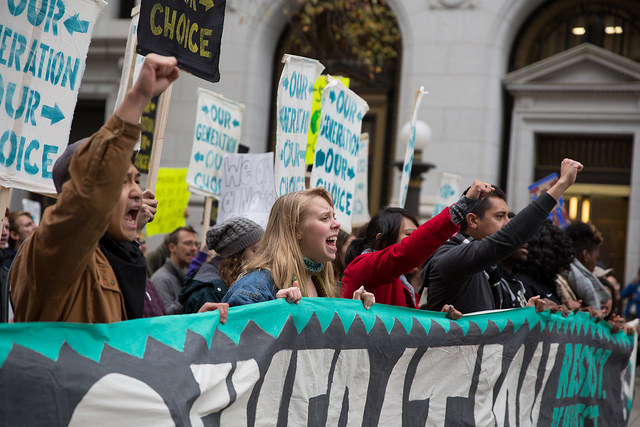
On November 9th in Washington, D.C., 1000 young people took the streets for justice on race, climate, and immigration. Photo: Maria Merkulova
Our Generation, Our Choice was a mobilization on race, climate and immigrant justice, led by a cross movement coalition aiming to make an intervention in the 2016 presidential election. For the first time, staff from Million Hoodies Movement, United We Dream, the Divestment Student Network and 350.org, and the young people our organizations work with, came together to work on a cross-issue project. This action involved roughly 6 weeks of planning with all of the partners involved, and resulted in a one-day training and a 1,000-person action on November 9th. You can watch the wrap up video here:
In the time since Our Generation, Our Choice, we’ve been reflecting on the action, our role in the mobilization, and where we go from here. We are committed to movement-building work for the long haul — and looking to the future, cross-movement and intersectional organizing must be a priority. Because we know this is a growing edge for us, and for many people and organizations in the climate movement, we want to share some of what we learned in hopes that it helps us all grow in this work. This post attempts to articulate a few hard, powerful lessons about how to do cross-movement work better.
We are excited about opportunities for strategic, cross-movement work.
Our Generation, Our Choice was ambitious and visionary from the start. We believe that to truly win on climate, we need to win alongside other movements for justice.
The oppressive systems creating political gridlock for progress on climate, racial justice and immigrant justice are intertwined, and therefore our fights against them needs to be intertwined. That truth was at the heart of the planning behind Our Generation, Our Choice. We need to find moments to leverage our collective power to win — and they can’t just be big tent organizing opportunities — they need to be powerful moments of intervention. Our Generation, Our Choice was a jumping-off point, and we believe we can and will keep building.
We saw the 2016 election as a prime opportunity for this kind of mobilizing. In the last year and a half, young people have put their bodies on the line for justice again and again, thereby mobilizing thousands of young people, shifting national discourse, and demanding more from our public institutions and politicians. Unifying these voices in the heart of DC, one year out from the election seemed like the perfect opportunity to build cross-movement power. And we did, but we missed a critical step…
We needed to build the table together.
Through relationship and conversation we needed to ensure that a truly representative group of partners and leaders were involved in the process at the very beginning (particularly important for risky or higher level action). We needed to plan at a pace and scale that matched everyone’s capacity and ability to take ownership of the action.
We needed more time to build a collective plan with our partners in order to get aligned about trainings, storytelling, action safety, turnout, and how we prepared people to show up. In the time we gave ourselves, we could not create the kind of trust and space for partners to state when the process wasn’t working for them, and we didn’t set clear expectations of how the action would turn out.
Both cross-movement and intersectional work require us to plan differently. They require us to work across culture, and therefore spend more time up front building trust together, establishing agreements, and creating best practices for collaboration.
Not skipping key steps.
We rushed this action, and there were consequences. The action story was unclear, turnout was lower and less diverse than expected, and not everyone felt comfortable in the space. In the divestment and reinvestment movement we have a training called ‘The Steps to Shared Power’. It is a framework for how build power and relationships across different campaigns, groups, and movements. The steps are as follows: Shared Stake → Shared Alignment → Shared Space → Shared Commitment → Shared Power. In the planning process for Our Generation, Our Choice, we did not take the time to fully build through each step. Because of the pace of the action planning we skipped from shared stake [an intervention on the 2016 election around these issues] to shared space [taking action + holding a training]. If we had spent more time building around shared alignment we would had an opportunity to adjust narrative, timeline, training, etc.
The story we tell needs to be representative, not just visionary.
When we take the time to build shared alignment we start to better understand our collective story, and as we develop that story, we can identify ways to share it through action. The story for Our Generation, Our Choice represented a vision for where our cross-movement work is headed, but did not center the stories of where we are now or the stories of those living at the intersections of our work.
We know that to fight for a stable climate, racial justice, and immigrant justice, we need to get at the intertwined roots of these crises. We win or lose together. That’s some serious motivation to apply what we’ve learned here. We need to give cross-movement work the time it deserves to build a solid foundation of trust and alignment. We need to balance public campaigning with building the deep relationships we need to have each others’ backs. We need to do better, deeper work at the intersection of our issues. And we need to learn from our mistakes, so we can get free together. A movement of movements has been rising, but these movements have faltered many times in the past around divisive politics. Our hope is that through learning our history and applying our own lessons, we can build together for justice.
By Katie McChesney & Yong Jung Cho